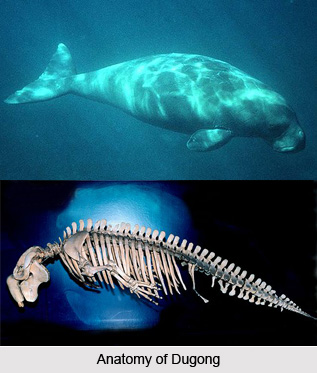 Dugong is popularly known as Sea cow. The mammalian order is Sirenia. This includes tow surviving genera - the monospecific dugong, Dugong dugon and the manatee, of which three species exist. The African continent separates the habitats of the two genera. Dugong occurs along some parts of the Indian Ocean coastline and, more commonly, in the western Pacific. Together with manatees, they form the only group of hervivorous marine mammals in existence.
Dugong is popularly known as Sea cow. The mammalian order is Sirenia. This includes tow surviving genera - the monospecific dugong, Dugong dugon and the manatee, of which three species exist. The African continent separates the habitats of the two genera. Dugong occurs along some parts of the Indian Ocean coastline and, more commonly, in the western Pacific. Together with manatees, they form the only group of hervivorous marine mammals in existence.
In Indian waters, the largest dugong population exists probably between India and Sri Lanka, in the Gulf of Mannar and in Palk Bay, where abundant pastures of sea grass meadows grow in the shallows, providing food. Dugongs are also known from the Gulk of Kutch and from the Andamans. They have been recorded in lengths ranging from roughly one to three metres and weights reaching an estimated four hundred kilograms.
Not infrequently, dugongs swim in family groups consisting of a single young and its parents. Their attachment to each other often results in the capture of the entire family if any one of the members is netted or harpooned. The young suckle from prominent nipples situated high up on the mother`s chest. The position of these (in the armpits under the flippers) is probably responsible for the old belief that sea-cows were mermaids. Sea-cows, in fact, are most closely related phylogenetically to elephants, sharing with them such traits as heavy bones, enlarged upper incisors (these miniature tusks occur in the male) and anteriorly-placed mammae. Dugongs do not stray far from coastal waters, and surface to breathe at intervals ranging from thirty seconds to 8.5 minutes. These habits render them easy prey for man.
Dugongs or sea cows have usually been hunted for meat. The fat underlying their skin, the skin itself and the tushes and bones have also been put to a variety of uses. Their keen sense of hearing has probably been instrumental in the continued survival of dugongs in areas where they were once abundant. Substantial populations survive today only in north Australian waters and some in the Indian waters. Twenty years has been suggested as the dugong`s longevity.



















